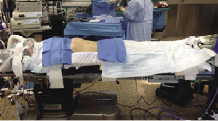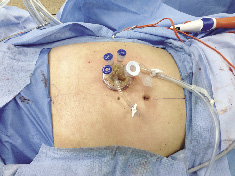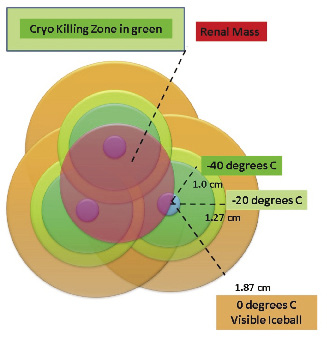 Indexed in Index Medicus and Medline
Indexed in Index Medicus and Medline
Free Articles
HOWIDOIT
How I do it: laparoscopic renal cryoablation (LRC)
Rodrigo Donalisio da Silva, MD,1 Paulo Jaworski, MD,1
Diedra Gustafson, BS,1 Leticia Nogueira,1 Francis Kang, MD,2
Wilson Molina, MD,1,2 Fernando J. Kim, MD1,2,3
1Division of Urology, Denver Health Medical Center, Denver, Colorado, USA
2Division of Urology, Department of Surgery, University of Colorado Denver, Denver, Colorado, USA
3University of Colorado Cancer Center Denver, Denver, Colorado, USA
DA SILVA RD, JAWORSKI P, GUSTAFSON D, NOGUEIRA L, KANG F, MOLINA W, KIM FJ. How I do it: laparoscopic renal cryoablation (LRC).
Can J Urol 2014;21(6):7574-7577.
Recently, diagnoses of small renal masses and renal cell carcinoma (RCC) have increased due to the widespread use of radiographic imaging studies (computerized tomography, magnetic resonance imaging). It appears that biological factors such as obesity and tobacco use increase the risk for RCC. In general, small malignant renal masses are low stage and low grade. The management of asymptomatic renal masses is a surgical challenge since overtreatment of benign masses is not desired, especially for patients with complex medical comorbidities, elderly patients, and those with impaired renal function.
Partial nephrectomy has been considered the gold standard when treating small renal masses. However, technical challenges and possible irreversible ischemia-reperfusion injury should be considered when treating these lesions. Preservation of renal function without compromising oncological control is the foundation for nephron-sparing surgery. Laparoscopic renal cryoablation (LRC) emerges as an option to treat small renal masses due to the less invasive procedure with low intraoperative complications rates, with no renal ischemia-reperfusion injury and comparable medium term follow up. It is our objective to demonstrate our technique to perform an effective small renal tumor cryoablation using the laparoscopic approach
Key Words: renal cancer, renal cryoablation, laparoscopic cryoablation
The diagnoses of small renal masses and renal cell carcinoma (RCC) have increased due to the widespread use of radiographic imaging studies.1 Partial nephrectomy has been considered the gold standard when treating small renal masses.2,3 However, technical challenges can lead to irreversible ischemia-reperfusion renal injury during the treatment of these lesions.2,3 Currently, the evolvement of technology allowed surgeons to treat the small renal lesions with thermo ablative techniques i.e.; cryoablation. Uchida et al described the use of liquid nitrogen to treat renal tumors with cryotherapy, resulting in low complication rates.4
Currently, the evolution of cryotechnology has allowed for the use of argon and helium gas for cryoablation and thawing respectively, with effective therapy of renal cancer cells even when performed by laparoendoscopic single-site surgery (LESS).5 The cryoablative site is categorized by two zones: a central zone characterized by coagulative necrosis, and a peripheral zone characterized by varying degrees of cellular death and injury.6 The mechanisms of cellular destruction and damage include both direct, immediate physical damage to cells, and more delayed cell death due to local hypoxia and apoptosis.6
The development of intraoperative ultrasound enabled real-time monitoring of tissue freezing. When ultrasound technology is used with new cryotherapy technology including the use of argon gas to freeze and helium gas to actively thaw, outcomes improved significantly for this less invasive technique.5
Preoperative care
Patients are informed to fast after midnight the day prior to the procedure. No bowel preparation is needed unless the patient previously had any extensive abdominal surgery.
Anesthesia and patients position
General anesthesia with muscle paralytics and endotracheal intubation are required. The patient is placed in a modified flank position at a 30-degree angle. The lower leg is flexed while the upper leg is extended. All pressure points are padded and the patient is secured to the table with 3 inch cloth tape, Figure 1. Special attention is required to prevent injury to the fibular, radial, brachial, and axillary nerves and plexus. The cloth tape is applied to the pelvis, shoulder, and legs above the knees to ensure the patient’s safety.
Pneumoperitoneum and trocars placement
Pneumoperitoneum is accomplished by placing a Verres needle in the umbilicus for patients who haven’t had previous abdominal surgery; or in the upper quadrant (left or right) with a CO2 insufflation pressure of 15 mHg-20 mmHg. For all anterior tumors, a LESS technique is performed through a single, peri-umbilical incision of 2.5 cm, Figure 2.
For other tumor locations, the placement requires the following:
a) one 5 mm trocar is placed at the sub-xiphoid site;
b) one 10 mm trocar at the umbilicus for a deflectable Endo-Eye camera (Olympus America Inc., Southborough, MA, USA);
c) another 12mm trocar at the mid-clavicular line as the entry point.
Renal dissection
After insertion of the camera, a review of the operative field is performed to inspect and detect unintentional injuries during trocar placement.
Visceral rotation of the colon is performed and only the tumor region should be carefully dissected. The kidney is exposed with minimal dissection after intraoperative ultrasonography is performed through the 12 mm trocar. The Gerota’s fascia is opened at the lesion site to expose the tumor. Perinephric fat surrounding the tumor is sent for pathology.
Cryoprobes placement
An initial 1.7 mm cryoprobe is inserted into the mass transabdominally through a skin puncture and placed into the lesion. The probe is anchored by freezing the tumor 1 mm-2 mm from the probe. Triangulation of two additional probes around the first probe ensures active formation of the ice ball with proper surgical margins. An effective “killing zone” temperature must be -20°C or below (up to 1.27 cm from the center of the cryoprobe). The visual iceball (from 1.27 cm to 1.87 cm mark from the center of the cryoprobe) is not effective to treat the cancer cells, Figure 3.
Cryoablation
Two freezing cycles of at least 6 minutes and two active thawing cycles are performed to effectively treat renal cancer and the cycles are monitored using real time laparoscopic ultrasonography until ultrasonographic imaging show soft tissue echogenicity in the center of the renal mass after thawing. The renal mass biopsy is performed between the first and second freezing cycle to ascertain optimal biopsy specimen and evaluate post biopsy bleeding.7
Cryoablation is performed using a third generation machine. Flowseal is then applied to the cryoablation site as an adjunct step for hemostasis. The Gerota’s fascia is closed at the end of the procedure with continuous absorbable 3.0 sutures with a small half circle non-traumatic needle.
We evaluated 50 consecutive renal tumor cryoablation cases after receiving the approval from our Institutional Review Board. Demographic data is represented in Table 1 and pathology data in Table 2.
Patients’ mean age was 55 years (range, 24-85 years). The mean tumor size was 2.7 cm (range, 1.9 cm-3.5 cm). The mean size of the biopsy specimen was 0.8 cm (range, 0.2 cm-2.3 cm). The diagnosis of tumor was rendered in 33 (66%) cases; 17 (34%) cases displayed normal renal cortical/medullary parenchyma. The tumor type was determined in 91% of diagnostic cases (30/33) as follows: clear RCC, 48.5% (16/33); papillary RCC, 27.3% (9/33); AML, 9% (3/33); renal tumor with eosinophilic cytoplasm, 11.4% (3/33); oncocytoma, 3% (1/33); and follicular lymphoma, 3% (1/33). Renal tumor with eosinophilia or eosinophilic cytoplasm is a descriptive terminology for tumors not classifiable further into other subtypes.7 Complications included the placement of ureteral stents in the ipsilateral kidney required 24 hrs-36 hrs after the primary procedure in two endophytic tumors that produce blood clots ureteral obstruction but these patients did not require blood transfusion or additional interventional procedures since they were hemodynamically stable. The ureteral stents were removed 2 weeks postop. There were no radiological recurrences or metastasis during the follow up period (mean of 176 months).8
A systematic review of the literature identified that laparoscopic renal cryoablation (LRC) has acceptable midterm (3-5 years) oncological outcomes with low recurrence rate. LRC has proven to be a safe procedure with a low overall complication rate. It can even be performed on elderly patients affected by comorbidity that are typically categorized as high surgical risk.3
Another systematic review and meta-analysis reported that laparoscopic renal cryoablation was associated with significantly shorter operative times, lower estimated blood loss, shorter length of stay, and decreased risk of perioperative complications when compared to laparoscopic and robotic partial nephrectomy. However, LRC is also associated with an increased risk for local recurrence and tumor progression.3 Balancing cancer management with the risk of perioperative complications is crucial for patient counseling and selecting the appropriate procedure. Currently, there are no prospective randomized controlled studies with long term follow up. Local recurrence after cryoablation can be well evaluated with contemporary tomographic studies and contrast enhancement.
Renal function after LRC has not shown impairment in our midterm follow up.8 Patients with solitary kidney that present renal tumors or patients with multiple tumors can benefit from a less invasive procedure that preserves renal function and increases the chance of having satisfactory functional outcomes, especially patients with the von Hippel-Lindau syndrome.8
The American Urological Association (AUA) recommends nephron sparing surgery (partial nephrectomy) as the standard of care for T1a renal tumors.3 Cryosurgery is considered first-line therapy that can be recommended to elderly patients, patients with multiple comorbidities, and patients with a solitary kidney.3 The definite oncological efficacy and renal function preservation will be delineated by future long term follow up studies. Moreover, recurrences after cryoablation may be related to the technique rather than the technology as demonstrated by studies treating other diseases i.e.; localized prostate cancer. 9,10
LRC is established as a less invasive and simpler surgical technique that is a great option for primary treatment of small renal neoplasms. It is associated with low complication rates and has very low impact on renal function. Patients with complex medical comorbidities, elderly patients, and those with impaired renal function appear to benefit from this technique for the treatment of small renal masses.
Accepted for publication October 2014
A video is available online at http://www.canjurol.com/ how-i-do-it.php
Address correspondence to Dr. Fernando J. Kim, Division of
Urology, Denver Health Medical Center-Urology, 777 Bannock
Street, MC0206, Denver, CO 80204 USA

Figure 1. Positioning of the patient.

Figure 2. Laparoendoscopic single-site surgery surgical technique.

Figure 3. Placement of cryoprobes (triangulation in relationship to renal mass).
| T1a | |
| Number of patients | 50 |
| Mean age (yrs) | 55 (24-85) |
| Mean tumor size | 2.7 cm (1.9-3.5) |
| Operating time, min | 78.1 ± 33.2 |
| Conversions, no. (%) | 3 (2.4%) |
| Major complications* | 2 (1.6%) |
| ΔeGFR (12 months) | 0.0 [0.0-5.5] |
| ΔeGFR (24 months) | [-4.5-0.0] |
| Follow up | 176 ± 72 mo. |
| Recurrences, no. (%) | 0 (0.0%) |
*Major complications were considered Clavien III-V. Two patients required ureteral stents to relieve blood clots in the collecting system.
Data presented as mean ± standard deviation, frequency (percentage of total), and median [interquartile range]
TABLE 2. Pathology diagnosis of small renal tumorsTop
| Pathology | No. of cases |
| Clear cell RCC* | 16 |
| Papillary RCC* | 9 |
| RT** with eosinophilic cytoplasm | 3 |
| Oncocytoma | 1 |
| Follicular lymphoma | 1 |
| Angiomyolipoma | 3 |
| Benign | 17 |
*renal cell carcinoma; **renal tumor
1. Van Poppel H. Joniau S. Is surveillance an option for the treatment of small renal masses? Eur Urol 2007;52(5):1323-1330.
2. Fergany AF, Hafez KS, Novick AC. Long-term results of nephron sparing surgery for localized renal cell carcinoma: 10-year follow up. J Urol 2000;163(2):442-445.
3. Campbell S.C, Novick AC, Belldegrun A et al. A recent review of the evidence-based literature on SRMs outlining standards of care for management with additional recommendations and options for surgical and nonsurgical treatment. AUA clinical guidelines: guideline for management of the clinical stage 1 renal mass; 2009. pp. 1–76.
4. Uchida M, Imaide Y, Sugimoto K, Uehara H, Watanabe H.
Percutaneous cryosurgery for renal tumours. Br J Urol 1995;75(2):
132-136.
5. Kaouk JH, Autorino R, Kim FJ et al. Laparoendoscopic single-site surgery in urology: worldwide multi-institutional analysis of 1076 cases. Eur Urol 2011;60(5):998-1005.
6. Maccini M, Sehrt D, Pompeo, A, Chicoli FA, Molina WR, Kim FJ.
Biophysiologic considerations in cryoablation: a practical mechanistic molecular review. Int Braz J Urol 2011;37(6):693-696.
7. Tayal S, Kim FJ, Sehrt D, Miano R, Pompeo A, Molina W. Histopathologic findings of small renal tumor biopsies performed immediately after cryoablation therapy: a retrospective study of 50 cases. Am J Clin Pathol 2014;141(1):35-42.
8. Donalisio da Silva R, Molina W, Kim FJ et al. Crioablacao Laparoscopica para tumors renais T1a e T1b: Analise de Resultados. Int Braz J Urol 2013;39(Suppl 1):147.
9. Donalisio da Silva R, Jaworski P, Gustafson D et al. How I do it: prostate cryoablation (PCry). Can J Urol 2014;21(2):7251-7254.
10. Kim FJ, Werahera PN, Sehrt DE et al. Ethnic minorities (African American and Hispanic) males prefer prostate cryoablation as aggressive treatment of localized prostate cancer. Can J Urol 2014;
21(3):7305-7311.

